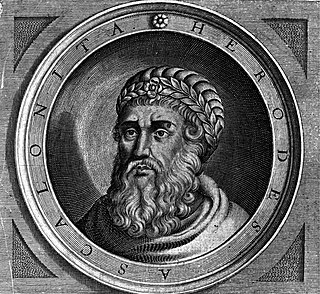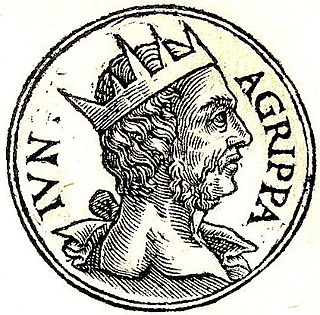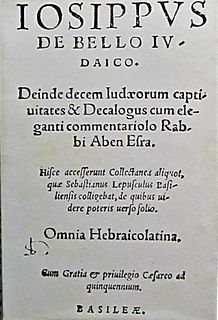| Selenophanes | |
|---|---|
 | |
| Scientific classification | |
| Kingdom: | Animalia |
| Phylum: | Arthropoda |
| Class: | Insecta |
| Order: | Lepidoptera |
| Family: | Nymphalidae |
| Genus: | Selenophanes Staudinger, [1887] [1] |
Selenophanes is a genus of Neotropical butterflies.
| Selenophanes | |
|---|---|
 | |
| Scientific classification | |
| Kingdom: | Animalia |
| Phylum: | Arthropoda |
| Class: | Insecta |
| Order: | Lepidoptera |
| Family: | Nymphalidae |
| Genus: | Selenophanes Staudinger, [1887] [1] |
Selenophanes is a genus of Neotropical butterflies.

Selenophanes cassiope, the cassiope owlet, is a butterfly of the family Nymphalidae. It was described by Pieter Cramer in 1775. It is found from Colombia through the Guianas to south-eastern Brazil.
The Essenes were a Jewish sect during the Second Temple period which flourished from the 2nd century BCE to the 1st century CE.

The extant manuscripts of the writings of the first-century Romano-Jewish historian Flavius Josephus include references to Jesus and the origins of Christianity. Josephus' Antiquities of the Jews, written around 93–94 AD, includes two references to the biblical Jesus Christ in Books 18 and 20 and a reference to John the Baptist in Book 18. Scholarly opinion varies on the total or partial authenticity of the reference in Book 18, Chapter 3, 3 of the Antiquities, a passage that states that Jesus the Messiah was a wise teacher who was crucified by Pilate, usually called the Testimonium Flavianum. The general scholarly view is that while the Testimonium Flavianum is most likely not authentic in its entirety, it is broadly agreed upon that it originally consisted of an authentic nucleus, which was then subject to Christian interpolation and/or alteration. Although the exact nature and extent of the Christian redaction remains unclear, broad consensus exists as to what the original text of the Testimonium by Josephus would have looked like.

Titus Flavius Josephus, born Yosef ben Matityahu, was a first-century Romano-Jewish scholar, historian and hagiographer, who was born in Jerusalem—then part of Roman Judea—to a father of priestly descent and a mother who claimed royal ancestry.

Titus was Roman emperor from 79 to 81. A member of the Flavian dynasty, Titus succeeded his father Vespasian upon his death, thus becoming the first Roman emperor to come to the throne after his own biological father.
The Sicarii were a splinter group of the Jewish Zealots who, in the decades preceding Jerusalem's destruction in 70 CE, heavily opposed the Roman occupation of Judea and attempted to expel them and their sympathizers from the area. The Sicarii carried sicae, or small daggers, concealed in their cloaks. At public gatherings, they pulled out these daggers to attack Romans and Hebrew Roman sympathizers alike, blending into the crowd after the deed to escape detection.

Herod, also known as Herod the Great and Herod I, was a Roman client king of Judea, referred to as the Herodian kingdom. The history of his legacy has polarized opinion, as he is known for his colossal building projects throughout Judea, including his expansion of the Second Temple in Jerusalem, the construction of the port at Caesarea Maritima, the fortress at Masada, and Herodium. Vital details of his life are recorded in the works of the 1st century CE Roman–Jewish historian Josephus. Herod also appears in the Christian Gospel of Matthew as the ruler of Judea who orders the Massacre of the Innocents at the time of the birth of Jesus. Despite his successes, including singlehandedly forging a new aristocracy from practically nothing, he has still garnered criticism from various historians. His reign polarizes opinion amongst scholars and historians, some viewing his legacy as evidence of success, and some as a reminder of his tyrannical rule.

Herod Agrippa II officially named Marcus Julius Agrippa and sometimes shortened to Agrippa, was the eighth and last ruler from the Herodian dynasty. He was the fifth member of this dynasty to bear the title of king, but he reigned over territories outside of Judea only as a Roman client. Agrippa was overthrown by his Jewish subjects in 66 and supported the Roman side in the First Jewish–Roman War.

The Hasmonean dynasty was a ruling dynasty of Judea and surrounding regions during classical antiquity. Between c. 140 and c. 116 BCE the dynasty ruled Judea semi-autonomously from the Seleucids. From 110 BCE, with the Seleucid Empire disintegrating, the dynasty became fully independent, expanded into the neighbouring regions of Samaria, Galilee, Iturea, Perea, and Idumea, and took the title "basileus". Some modern scholars refer to this period as an independent kingdom of Israel.
The Sadducees were a sect or group of Jews that was active in Judea during the Second Temple period, starting from the second century BC through the destruction of the Temple in 70 AD. The sect was identified by Josephus with the upper social and economic echelon of Judean society. As a whole, the sect fulfilled various political, social, and religious roles, including maintaining the Temple. The Sadducees are often compared to other contemporaneous sects, including the Pharisees and the Essenes. Their sect is believed to have become extinct some time after the destruction of Herod's Temple in Jerusalem in 70 AD, but it has been speculated that the later Karaites may have had some roots in—or connections with—Sadducaic views.

Herod Antipater, known by the nickname Antipas, was a 1st-century ruler of Galilee and Perea, who bore the title of tetrarch and is referred to as both "Herod the Tetrarch" and "King Herod" in the New Testament although he never held the title of king. He is widely known today for accounts in the New Testament of his role in events that led to the executions of John the Baptist and Jesus of Nazareth.

Josephus Daniels was a newspaper editor and publisher from North Carolina who became active in politics. A progressive Democrat, he was appointed by United States President Woodrow Wilson to serve as Secretary of the Navy during World War I. He became a close friend and supporter of Franklin D. Roosevelt, who served as his Assistant Secretary of the Navy and later was elected as United States president. Roosevelt appointed Daniels as his Ambassador to Mexico, 1933-41.
The Zealots were a political movement in 1st-century Second Temple Judaism, which sought to incite the people of Judea Province to rebel against the Roman Empire and expel it from the Holy Land by force of arms, most notably during the First Jewish–Roman War (66–70). Zealotry was the term used by Josephus for a "fourth sect" or "fourth Jewish philosophy" during this period.

The siege of Masada was one of the final events in the First Jewish–Roman War, occurring from 73 to 74 CE on and around a large hilltop in current-day Israel.
Judas of Galilee, or Judas of Gamala, was a Jewish leader who led resistance to the census imposed for Roman tax purposes by Quirinius in Judea Province around 6 CE. He encouraged Jews not to register and those that did had their houses burnt and their cattle stolen by his followers. He began the "fourth philosophy" of the Jews which Josephus blames for the disastrous war with the Romans in 66–70 CE. These events are discussed by Josephus in The Jewish War and in Antiquities of the Jews and mentioned in the Acts of the Apostles.

Antiquities of the Jews is a 20-volume historiographical work, written in Greek, by the Jewish historian Flavius Josephus in the 13th year of the reign of Roman emperor Flavius Domitian which was around AD 93 or 94. Antiquities of the Jews contains an account of history of the Jewish people for Josephus' gentile patrons. In the first ten volumes, Josephus follows the events of the historical books of the Hebrew Bible beginning with the creation of Adam and Eve.

The Jewish War or Judean War, also referred to in English as The Wars of the Jews, is a book written by Josephus, a Roman-Jewish historian of the 1st century.

The Siege of Jerusalem in the year 70 CE was the decisive event of the First Jewish–Roman War. The Roman army, led by the future Emperor Titus, with Tiberius Julius Alexander as his second-in-command, besieged and conquered the city of Jerusalem, which had been controlled by Judean rebel factions since 66 CE, following the Jerusalem riots of 66, when the Judean provisional government was formed in Jerusalem.

Herod Archelaus was ethnarch of Samaria, Judea, and Idumea, including the cities Caesarea and Jaffa, for a period of nine years. Archelaus was removed by Roman Emperor Augustus when Judaea province was formed under direct Roman rule, at the time of the Census of Quirinius. He was the son of Herod the Great and Malthace the Samaritan, and was the brother of Herod Antipas, and the half-brother of Herod II. Archelaus came to power after the death of his father Herod the Great in 4 BC, and ruled over one-half of the territorial dominion of his father.
A synedrion or synhedrion is an assembly that holds formal sessions. The Latinized form is synedrium.
Pleistoros was, according to Herodotus, a Thracian god adored by the Gauls and the tribe "Absinthe" as the god of war. According to Josephus Flavius (in his Antiquities of the Jews, XVIII, 22, Pleistoros was the god of war Dacians pleistoi, to which these Thracians offered sacrifices of men. The priests were recruited between nobles, some of whom are warriors..
| Wikimedia Commons has media related to Selenophanes . |
| Wikispecies has information related to Selenophanes |
| This Morphinae article is a stub. You can help Wikipedia by expanding it. |